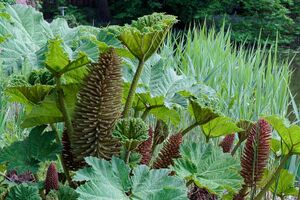Gunnera Cyanobacteria symbiosis: Difference between revisions
No edit summary |
No edit summary |
||
| Line 5: | Line 5: | ||
==<i>Cyanobacteria</i>== | ==<i>Cyanobacteria</i>== | ||
<ref>[https://www.sciencedirect.com/science/article/pii/S0168945207003202?via%3Dihub Sinha, R. P., & Häder, D. P. (2008). UV-protectants in cyanobacteria. <i>Plant Science</i>, 174(3), 278-289.]</ref> | Cyanobacteria are the largest phylum of Gram-positive prokaryotes on earth. They are known for their ability to obtain energy through photosynthesis <ref>[https://www.sciencedirect.com/science/article/pii/S0168945207003202?via%3Dihub Sinha, R. P., & Häder, D. P. (2008). UV-protectants in cyanobacteria. <i>Plant Science</i>, 174(3), 278-289.]</ref>. The ability to produce oxygen is believed to be an attribute to their success in evolution because the environment in which they were developing was otherwise occupied by anaerobic bacteria <ref>[https://books.google.com/books?hl=en&lr=&id=4oJ_vi27s18C&oi=fnd&pg=PR3&dq=Whitton+BA,+ed.+(2012).+%22The+fossil+record+of+cyanobacteria%22.+Ecology+of+Cyanobacteria+II:+Their+Diversity+in+Space+and+Time.+Springer+Science+%26+Business+Media.+pp.+17%E2%80%93.+&ots=JG1mYJsMTT&sig=yuPO7pmok3mkSV5sDkrOn0uGc4U#v=onepage&q=Whitton%20BA%2C%20ed.%20(2012).%20%22The%20fossil%20record%20of%20cyanobacteria%22.%20Ecology%20of%20Cyanobacteria%20II%3A%20Their%20Diversity%20in%20Space%20and%20Time.%20Springer%20Science%20%26%20Business%20Media.%20pp.%2017%E2%80%93.&f=false Whitton, B. A. (Ed.). (2012). <i>Ecology of cyanobacteria II: their diversity in space and time</i>. Springer Science & Business Media.]</ref>. | ||
Many species live in large colonies of cells ranging from hundreds to thousands of cells in a single colony <ref>[https://www.ncbi.nlm.nih.gov/pmc/articles/PMC3138769/ Tamulonis, C., Postma, M., & Kaandorp, J. (2011). Modeling filamentous cyanobacteria reveals the advantages of long and fast trichomes for optimizing light exposure. <i>PLoS One</i>, 6(7), e22084.]</ref>. | |||
<ref>[https://www.ncbi.nlm.nih.gov/pmc/articles/PMC3138769/ Tamulonis, C., Postma, M., & Kaandorp, J. (2011). Modeling filamentous cyanobacteria reveals the advantages of long and fast trichomes for optimizing light exposure. <i>PLoS One</i>, 6(7), e22084.]</ref> | |||
==Section 2 Microbiome== | ==Section 2 Microbiome== | ||
Revision as of 12:40, 5 November 2021
Gunnera

Cyanobacteria
Cyanobacteria are the largest phylum of Gram-positive prokaryotes on earth. They are known for their ability to obtain energy through photosynthesis [1]. The ability to produce oxygen is believed to be an attribute to their success in evolution because the environment in which they were developing was otherwise occupied by anaerobic bacteria [2].
Many species live in large colonies of cells ranging from hundreds to thousands of cells in a single colony [3].
Section 2 Microbiome
Include some current research, with a second image.
Conclusion
Overall text length (all text sections) should be at least 1,000 words (before counting references), with at least 2 images.
Include at least 5 references under References section.
References
- ↑ Sinha, R. P., & Häder, D. P. (2008). UV-protectants in cyanobacteria. Plant Science, 174(3), 278-289.
- ↑ Whitton, B. A. (Ed.). (2012). Ecology of cyanobacteria II: their diversity in space and time. Springer Science & Business Media.
- ↑ Tamulonis, C., Postma, M., & Kaandorp, J. (2011). Modeling filamentous cyanobacteria reveals the advantages of long and fast trichomes for optimizing light exposure. PLoS One, 6(7), e22084.
Edited by Rachael Tomasko, student of Joan Slonczewski for BIOL 116 Information in Living Systems, 2021, Kenyon College.
